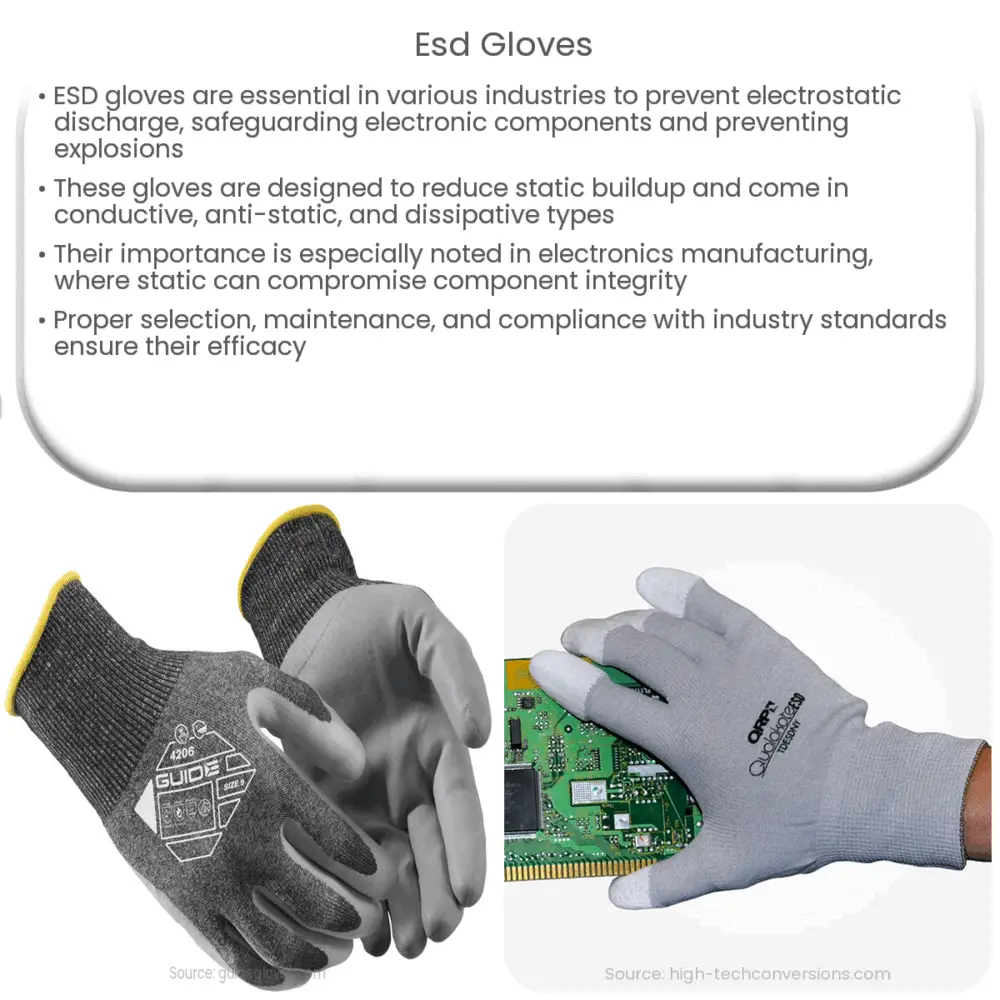Explore the world of ESD gloves: their importance, types, uses across industries, maintenance tips, and their future relevance.

Understanding ESD Gloves
Electrostatic discharge (ESD) gloves are a critical component in many industries. They are used to prevent electrostatic discharge, which can damage sensitive electronic components or potentially cause an explosion in a flammable environment. The importance of ESD gloves in industries cannot be overstated. In this article, we delve into the world of ESD gloves, their functionality, applications, and benefits.
The Essence of ESD Gloves
ESD gloves are specially designed gloves that help reduce the buildup of static electricity. They are typically made of materials that are conductive or anti-static, which allows them to dissipate static charges effectively. They prevent static buildup by facilitating the flow of electric charges from the body to the object being handled or vice versa. There are several types of ESD gloves, each with specific features and suitable for various applications.
Types of ESD Gloves
- Conductive Gloves: These are made of materials like rubber or latex that are inherently conductive. They are often used in environments where there’s a high risk of static buildup, such as in electronic assembly or handling of flammable materials.
- Anti-Static Gloves: These are typically made of synthetic materials that have been treated to resist static buildup. They are suitable for handling sensitive electronic components where static discharge could cause damage.
- Dissipative Gloves: These gloves help to dissipate static charges slowly to prevent sudden, potentially damaging electrostatic discharges. They are often used in cleanrooms and laboratories.
The Importance of ESD Gloves
ESD gloves are crucial in a variety of industries. Whether it’s in electronics manufacturing, the automobile industry, or the biomedical field, these gloves serve to protect both the products and the workers. They ensure safety, prevent product defects, and contribute to the overall efficiency of operations. Their role in maintaining the integrity of electronic components and devices, in particular, cannot be overstated.
ESD Gloves in Electronics Manufacturing
Electronics manufacturing is one industry where ESD gloves play a particularly significant role. During the assembly and handling of electronic components, even the slightest static discharge can cause component failure, affecting the entire device’s functionality. Hence, the use of ESD gloves is integral in maintaining the integrity and reliability of electronic devices.
Choosing the Right ESD Gloves
It’s essential to select the right type of ESD gloves for a specific task or environment. When choosing ESD gloves, several factors must be taken into account. These include the glove’s resistance level, material, size, and comfort. The gloves should also be compliant with relevant industry standards for ESD protection.
Maintenance of ESD Gloves
Like any other protective equipment, ESD gloves also require proper maintenance to ensure they continue to perform optimally. Regular cleaning and inspection are necessary to maintain their anti-static properties. Also, they should be replaced periodically as wear and tear can impair their ability to dissipate static effectively.
ESD Gloves Beyond Electronics Manufacturing
While the electronics manufacturing industry is a significant user of ESD gloves, their application goes beyond this sector. Other industries, such as pharmaceuticals and aerospace, also rely on ESD gloves to prevent static-induced damage. In the medical field, ESD gloves are used during surgeries to protect delicate medical equipment. In the aerospace industry, these gloves help prevent potential ignition of flammable materials.
The Future of ESD Gloves
As technology continues to advance, so too does the importance of ESD gloves. With electronic components becoming increasingly sensitive, the demand for ESD gloves will likely continue to grow. Moreover, ongoing research and development efforts aim to improve the functionality and comfort of ESD gloves, further enhancing their effectiveness in protecting both products and workers from the dangers of electrostatic discharge.
Conclusion
In conclusion, ESD gloves play a vital role in a multitude of industries. They are crucial in protecting sensitive electronics from damage and preventing potential hazards associated with electrostatic discharge. By choosing the appropriate gloves for specific tasks and maintaining them correctly, companies can ensure the safety of their employees and the integrity of their products. As we move towards a more technologically advanced future, the significance of ESD gloves will only continue to increase.

